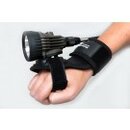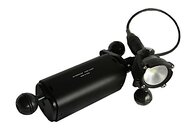With cordless primary lights becoming increasingly commonplace in diving and seem to be advancing in technology rather quickly(like light and battery technology in general). So with that in mind, if you still use a corded primary light at what point in their advancement would you consider switching to a cordless one? Burn time? Brightness? Proven track record of dependability?
I know I personally made the switch to the Dive Rite RX-20 because the burn times and brightness were comparable to my 10W LED corded primary.
My wife Sandra is looking for a light right now, that she can use for her night dives at the BHB Marine Park.....Her Halcyon Explorer does a good job of helping her in her scouting for finding more nudibranchs, or other tiny creatures, so she can set up to photograph them with 100 mm lens and 7x diopter, but the Halcyon light she has only lasts 2 hours...... ( she does dives that last between 3 and 6 hours routinely....though most night dives have time restrictions preventing her from being in past 4 hours)
So while the Halcyon is a great light, it has two issue for her.....first, the burn time, which can be dealt with by going to one of the larger Halcyon canister lights...
The second issue is more related to the issue with the cordless lights....Sandra DOES NOT like to have to carry a large light head on her wrist---while the goodman style light of the halcyon explorer does allow hands free operation, the size and weight make it difficult for her to be handling all the controls of her camera, with the light on top of her wrist....Now the cordless lights would be TERRIBLE for her, as there is no way she could actually hang on to them with one hand and shoot pics...and if she rigged one with a Goodman handle, it would make the Halcyon Explorer light head seem very compact and comfortable in comparison...

I don't really know why anyone would purposely want such a large light to be in your way, in your hand, preventing you from the use of that hand you may need for shooting or something else--especially when you have Can lights around to keep you hands free....or mostly hands free

We have been looking at this...
STRYKR C1800 Combo Kit, 8-Cell, 150M - 1800 Lumen


Because it has a goodman similar on top of wrist way of being held so you are hands free....AND, the light head is a fraction the size of the light heads on the Can lights we are used to, so Sandra is looking forward to trying one to see if it is less intrusive...the Light power, from what we see on paper, would seem to be along the same order as the Halcyon lights.....with multiple power settings, and burn times that will last even through one of Sandra's 6 hour long dives at the BHB.
Does anyone have any experience with this light by watershot, or any other light suggestions?






